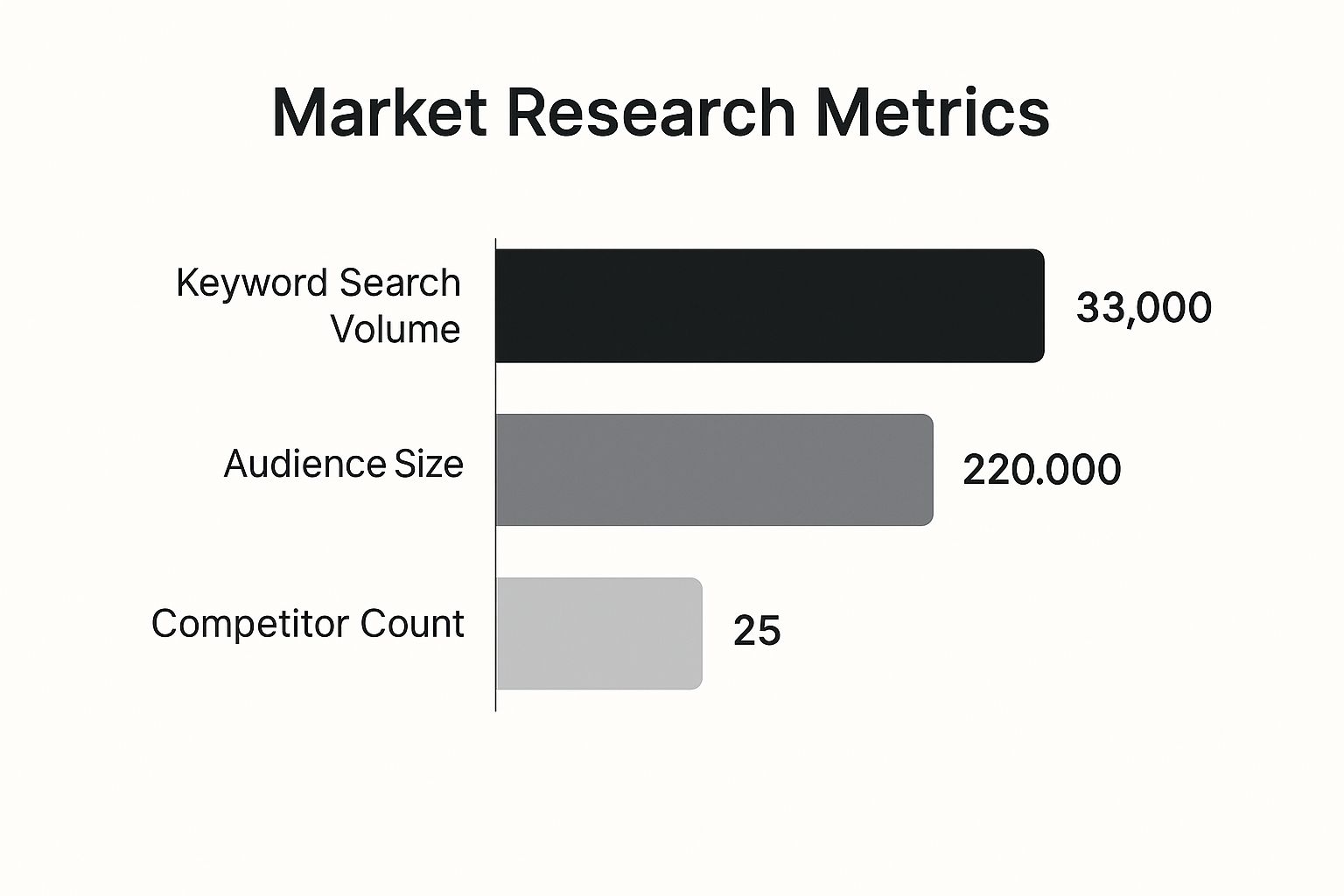Navigating The Startup Digital Marketing Reality Check
Let's get one thing straight: most of the marketing advice you read online feels like it was written for a different universe. It assumes big budgets, established brands, and a level of resources that most startup founders can only dream of. A real digital marketing strategy for startups isn't about ticking every box or chasing every trend. It's about making tough, smart decisions with what you have. It’s about knowing the difference between activities that build real momentum and those that just look good on a progress report.
This means you need to shift your thinking from "what could we do?" to "what must we do right now?" Forget the pressure to be everywhere at once. Your first mission is to find one or two places where your ideal customers are genuinely hanging out online and focus on winning there. Before you dive deep, getting a handle on some foundational tactics can be a game-changer; these essential digital marketing tips for small business success are a great starting point and highly relevant for early-stage companies.
Finding Your Niche in a Crowded Market
Before you even think about spending a single dirham on ads, your first job is to become an expert on your market. This is more than just making a list of competitors. You have to understand the digital environment you’re stepping into. For example, the digital advertising market across the Middle East and Africa is projected to hit USD 31.99 billion in 2024. A massive 55.36% of that revenue comes from smartphones, thanks to the region's incredibly high mobile penetration.
This isn't just a fun fact; it's a critical piece of intelligence. It tells you that a mobile-first approach isn't just a good idea—it's non-negotiable. You can dig deeper into this data by exploring the full digital advertising market research. A desktop-heavy campaign in a market where everyone is on their phone is a guaranteed way to burn through your cash with little to show for it.
Start by asking some practical questions:
- Where do my ideal customers actually go to find solutions? Is it Google search, specific online forums, Instagram, or professional groups on LinkedIn?
- What type of content are they already consuming and sharing? Are they watching video tutorials, reading in-depth guides, or engaging with quick social media tips?
- What are my competitors' biggest marketing weaknesses? Do they have terrible SEO, a ghost town for a social media page, or a string of bad online reviews?
Answering these questions honestly will shine a light on the specific gaps you can exploit. It’s not about outspending the big players; it's about outsmarting them in the areas they’re neglecting.
To help you decide which channels are the best fit for your startup's specific situation, we've put together a comparison table. This breaks down popular digital marketing channels based on the factors that matter most to an early-stage company: budget, time, and complexity.
| Channel | Initial Investment | Time to Results | Complexity Level | Best for Startups |
|---|---|---|---|---|
| SEO | Low to Medium | 6-12 Months | High | Building long-term, sustainable traffic and authority. Ideal for B2B and content-heavy businesses. |
| Content Marketing | Low to Medium | 3-6 Months | Medium | Establishing expertise and trust. Perfect for startups with a strong point of view. |
| Social Media Marketing | Low (Organic) | 1-3 Months | Medium | Building community and brand personality. Great for visual products and direct customer engagement. |
| PPC Advertising | Medium to High | Immediate | High | Driving targeted traffic and leads quickly. Excellent for validating product-market fit. |
| Email Marketing | Low | Immediate | Low to Medium | Nurturing leads and retaining customers. A must-have for nearly every startup. |
| Influencer Marketing | Low to High | 1-2 Months | Medium | Gaining instant credibility and reach. Effective for consumer-facing brands. |
This table shows there’s no single "best" channel. The right choice depends entirely on your goals, resources, and timeline. A startup needing immediate sales data might lean on PPC, while one building a long-term brand might invest heavily in SEO and content from day one.
Balancing Ambition with Reality
Once you have a better feel for the competitive landscape, it’s time to map out where your best opportunities are. This involves comparing key data points to find that sweet spot between a large potential audience and low market saturation.
The chart below shows the kind of analysis you should be doing during your research. It helps you visually identify your strategic battleground.

This type of analysis helps you pinpoint niches that have high audience interest but lower competition—the perfect place for a startup to make its mark. By focusing your limited resources here, you can gain visibility and traction much more efficiently than by trying to compete on broad, crowded terms. This data-driven approach is the bedrock of a startup marketing strategy that is both realistic and effective.
Creating Your Digital Infrastructure Without Breaking The Bank

Before you can bring any part of your startup's marketing plan to life, you need a solid digital foundation. This isn’t about splashing out on flashy websites or subscribing to every "must-have" tool. It’s about building a lean, functional infrastructure that supports your growth instead of draining your cash reserves. Think of it as laying the plumbing and wiring in a house before you start painting the walls; get it right, and everything else works as it should.
Many startups get stuck here, believing they need a perfect, feature-packed website from day one. The truth is, a simple, professional, and mobile-friendly site is all you need to get going. What’s even more important is making sure your website loads quickly. Since most customers do their research on their phones, a slow site is a surefire way to lose business before you've even had a chance to say hello.
Choosing Your Essential Startup Toolkit
Once your basic website is up, the next job is picking the right tools. The market is flooded with options, which can feel overwhelming. This is especially true in fast-growing regions. For example, the digital marketing software sector in the Middle East and Africa is expected to grow at a compound annual growth rate (CAGR) of 12.85% between 2025 and 2032. The UAE alone accounted for market revenue of nearly $1.12 billion in 2024, showing just how much is being invested in these tools. You can find more details in the complete market analysis on digital marketing software.
More growth means more choices, but also more noise. The trick is to start with the absolute essentials and ignore the temptation of "feature bloat." Focus on a core set of tools that solve your immediate problems. Here’s a practical starter stack that works for most startups:
- Website & Analytics: A straightforward website builder like WordPress or Webflow combined with Google Analytics is non-negotiable. This gives you an online home and the data to understand who’s visiting and what they’re doing.
- Customer Relationship Management (CRM): Don't overdo it. A free or low-cost CRM helps you organise your leads and customer conversations from the start. It’s a habit that will pay off massively as you grow.
- Email Marketing: A platform for sending newsletters and automated messages is vital for nurturing leads. Many providers offer generous free plans that are perfect for when you're just starting out.
- Social Media Scheduling: A basic tool to plan and schedule your social media posts will save you countless hours and keep your presence consistent.
The following screenshot shows the projected growth and segmentation of the digital marketing software market in the Middle East and Africa, highlighting the various tool categories available.

As the chart shows, big money is flowing into areas like marketing automation and content management, confirming their importance. The secret for a startup is to pick tools that work well together. This creates a smooth workflow that saves time rather than making more manual work. By being selective and focusing on this foundational tech stack, you build a powerful yet cost-effective setup that’s ready to support your marketing efforts.
Understanding Your Customers Beyond Demographics
A solid technical setup is essential, but it’s only half the story. The most impressive digital infrastructure is pointless if you're broadcasting your message to the wrong people, or even to the right people but with the wrong message. This is a common pitfall for many startups. They sketch out a basic customer profile—"males aged 25-40, living in Dubai, interested in tech"—and consider the job done. This superficial approach is a fast track to wasted ad spend and marketing that simply doesn't connect. A truly effective digital marketing strategy for startups is built on a foundation of deep, almost obsessive, customer understanding.
It’s about digging past the surface-level data to find the real human beings on the other side of the screen. What are their hidden frustrations? What emotional triggers influence their buying decisions? What words do they use when they describe their problems to friends? This is the gold you need to be mining.
Moving from Assumptions to Actionable Insights
The first move is to accept that most of your initial assumptions about your customers are probably off the mark. The goal isn't just to confirm what you think you know; it's to discover what you don't. For startups with tight budgets, this research doesn't call for expensive focus groups. It just demands effort and a genuine willingness to listen.
Here are some practical, low-cost ways to gather these insights:
- Conduct Customer Interviews (Even with Just 5 Customers): Talk to your earliest adopters, or even people you believe should be your customers. Don't pitch them. Instead, ask open-ended questions about their workflow, their biggest challenges, and how they've tried to solve those problems before. Your aim is to get them to tell you stories.
- Become a Digital Lurker: Find the online communities where your potential customers gather. This could be Reddit subreddits, Facebook groups, or niche industry forums. Pay close attention to the questions they ask, the frustrations they vent, and the solutions they recommend to one another. This is unfiltered, candid market research at its finest.
- Analyse Competitor Reviews: Meticulously read the 1-star and 5-star reviews of your competitors. The glowing reviews tell you what people value most, while the negative ones highlight unmet needs and pain points you could potentially address.
This research helps you paint a much richer picture of your target audience. The chart below shows how a target audience can be segmented using various factors, including the psychographics you're trying to uncover.
The key takeaway here is that demographics are just one piece of the puzzle. A genuinely effective strategy gives just as much weight to psychographics, geographics, and behaviour.
Creating Personas That Actually Work
The culmination of this research is the customer persona. This isn't just a document to create and file away; it should be a living tool that guides every single marketing decision you make. A good persona goes far beyond demographics. It should feel like a real person because it's built on real data.
Your persona should include:
- Goals: What are they trying to achieve, both in their professional and personal lives?
- Pain Points: What specific obstacles are standing in their way?
- Motivations: What are the emotional drivers behind their goals? Is it a desire for recognition, efficiency, or security?
- Watering Holes: Where do they get their information? Which blogs do they read? Which influencers do they follow?
- Direct Quotes: Include actual phrases you heard during your research. This helps keep your marketing copy grounded in the customer's real voice.
By developing one or two of these detailed personas, you create a North Star for your marketing. Before you write a blog post, design an ad, or send an email, you can ask a simple question: "Would [Persona Name] find this valuable?" This simple check ensures your efforts are always customer-centric, shifting your digital marketing strategy for startups from a guessing game to a calculated plan.
Mastering Your Core Marketing Channels
Once you have a real sense of who your customers are, the next great challenge is figuring out where to find them. The biggest mistake a startup can make is falling for "channel FOMO"—the fear of missing out that leads you to spread your limited resources thinly across every platform imaginable. A far more effective digital marketing strategy for startups involves intense focus. Instead of being average on ten channels, your goal is to be exceptional on two or three.
This means you need a practical way to decide where to invest your precious time and money. It’s a disciplined process of matching your business reality—your budget, team skills, and product type—with how your target customers behave online. A B2B SaaS company selling complex software, for example, will find its first customers in very different places than a direct-to-consumer brand selling handmade jewellery. The former might double down on LinkedIn and in-depth content marketing, while the latter might flourish on Instagram and TikTok.
Choosing Your Battlefield: A Practical Evaluation
To avoid choosing channels based on gut feelings or what seems popular, you need to assess each option against a clear set of criteria. Think of this as your channel selection scorecard. For every potential channel, from SEO to paid social ads, ask yourself these tough questions:
- Audience-Channel Fit: Is my ideal customer actively using this platform to find solutions or products like mine? Evidence, not assumptions, is key here.
- Resource Alignment: Do we have the skills, budget, and time required to compete effectively on this channel? For instance, high-quality video for YouTube demands different resources than technical blog posts for SEO.
- Time to Impact: How long will it realistically take to see a return on this channel? Paid ads can deliver results in days, while SEO is a long-term investment that can take 6-12 months to bear fruit. You need a mix that aligns with your runway.
- Scalability: If this channel works, can we scale our efforts efficiently? A channel that relies solely on the founder's personal network, for instance, has a natural ceiling.
This structured approach prevents you from burning through your budget on expensive lessons. It forces you to be honest about your capabilities and focus your energy where it will have the greatest effect. The following chart offers a simplified view of how different digital marketing channels are categorised.
This illustrates the wide array of tactics available, underscoring why a startup must be selective. Trying to master all of these at once is a recipe for failure.
Mastering Your Chosen Channels
Once you've identified your primary channels, the next stage is mastery. This isn't just about posting regularly; it's about deeply understanding the unwritten rules and nuances of each platform.
- For Content & SEO: Focus on creating content that is genuinely useful, not just keyword-stuffed. Research shows that nearly half of all buyers consume 3-5 pieces of content before even contacting a sales representative. Your goal is to be that trusted resource. Create detailed guides, case studies, or tools that solve a real problem for your customer persona.
- For Paid Advertising: Start with a very small, controlled budget. Your initial goal isn’t to drive thousands of sales; it's to gather data. Test different ad creatives, headlines, and audience segments to see what resonates. A small investment in learning can save you a fortune down the line.
- For Social Media: Don't just broadcast; build a community. Engage in conversations, answer questions promptly, and showcase the human side of your brand. Consistency is more important than frequency. A steady, authentic presence builds trust over time. You can learn more by exploring our detailed guide on digital marketing for startups, which offers further insights into channel-specific tactics.
The key is to maintain this laser focus. Resist the urge to add a new channel until you have built a predictable, repeatable system for acquiring customers from your first one or two. That discipline is what separates the startups that achieve sustainable growth from those that run out of steam.
Measuring What Actually Matters For Growth

It’s easy to drown in data. As a startup, you can quickly get lost in beautiful dashboards full of "vanity metrics"—those impressive-sounding numbers like social media impressions or total website visitors that don’t actually tell you if your business is growing. A smart digital marketing strategy for startups isn't about collecting the most data; it's about measuring what truly matters to make better decisions. The key is to shift from just tracking activity to measuring real impact.
This means focusing your measurement on metrics directly tied to your business goals, such as customer acquisition cost (CAC) or conversion rates. Think of it this way: your website traffic is the number of people window shopping, while your conversion rate is the number of people who actually walk in and make a purchase. Both are interesting, but only one pays the bills. The discipline lies in concentrating on the metrics that signal genuine business health, even when the vanity metrics feel more flattering.
Distinguishing Signal from Noise
Your first task is to sort your metrics into a hierarchy. Not all data points need your daily attention. Some are quick health checks, while others are for monthly strategic reviews. This focus is becoming essential as businesses in our region increasingly rely on data. Digital marketing analytics in the Middle East and Africa is already a USD 90.36 million market in 2024 and is expected to grow at a strong 20.6% CAGR through 2031. This growth is driven by a wider corporate shift towards data-informed decision-making. You can explore more on the regional analytics market growth to see the full picture.
This sharp upward trend means your competitors are almost certainly using analytics to gain an advantage, making a solid measurement framework vital for your own survival and growth. Ultimately, the goal is to achieve a measurable return. You can discover proven strategies to improve marketing ROI and sidestep common mistakes. For a deeper look at setting up the right systems, our guide on effective marketing campaign tracking is a great resource.
To help you get started, here’s a table that breaks down which metrics to focus on at different stages of your startup's journey. It shows what to track, how often, and what good performance looks like.
| Growth Stage | Key Metrics | Tracking Frequency | Typical Benchmarks | Action Triggers |
|---|---|---|---|---|
| Pre-Seed/Seed (Awareness & Validation) | Website Sessions, Social Media Reach, Email Subscribers, Content Downloads | Weekly | 10%+ Weekly Growth in Subscribers | Low engagement rates, high bounce rates |
| Series A (Acquisition & Engagement) | Conversion Rate, Leads Generated, Customer Acquisition Cost (CAC) | Daily/Weekly | 2-5% Conversion Rate (Industry-dependent) | CAC exceeds CLV, low lead-to-customer ratio |
| Series B (Scaling & Optimisation) | Customer Lifetime Value (CLV), CAC to CLV Ratio, Funnel Conversion Rates | Monthly | CLV:CAC Ratio of 3:1 or higher | Declining CLV:CAC ratio, high churn rate |
| Growth/Maturity (Retention & Expansion) | Churn Rate, Repeat Purchase Rate, Net Promoter Score (NPS) | Monthly | <5% Monthly Churn (SaaS) | Rising churn, drop in repeat purchases |
This structured approach helps you zero in on the right numbers at the right time. For an early-stage startup, a rising number of email subscribers (a middle-funnel metric) might be a more critical signal of future success than raw website traffic. It proves you're not just attracting eyeballs but capturing genuine interest from people who want to hear from you again. This is the art of measuring what actually moves the needle for your business.
Scaling Beyond Your First Marketing Wins
That first rush of success is incredible. You’ve cracked a channel, brought in your first proper customers, and proved your idea has real potential. But let’s be honest: the scrappy, hustle-heavy tactics that landed your first 100 customers are rarely what will get you to your next 1,000. Success brings new problems, and what was once a simple process can quickly turn into a bottleneck. This is the moment where a startup’s digital marketing strategy has to shift from early-stage hustle to a scalable growth engine.
Scaling isn’t just about doing more of the same. It’s about building systems and processes that can manage a bigger workload without you having to throw more and more manual effort at it or watch your quality drop. The trick is to spot when your current methods are stretched to their limits. Are you spending more time managing logistics than creating? Are your customer acquisition costs slowly rising as you try to reach more people? These are tell-tale signs that it’s time to build a system. It requires a mental shift from just doing tasks to creating repeatable marketing playbooks.
The image below shows how business scaling works—achieving growth by adding resources to a model that is already proven and repeatable.
This visual makes it clear that true scaling is about creating a system that can grow efficiently, not just get bigger. For a startup, this means turning your successful marketing experiments into documented, repeatable processes that anyone on your team can follow.
From Hustle to Systemised Growth
The first step in scaling is to figure out which parts of your marketing are both working well and can be repeated. This is where you’ll build your first proper systems. Take a look at your most successful channel. What specific actions brought you your best customers? Write down every single part of that process, from how you create the content to how you follow up with leads.
This documentation becomes your very first marketing playbook. For instance, if you struck gold with targeted content on LinkedIn, your playbook might look something like this:
- A checklist for researching and writing posts.
- Templates for outreach messages you can personalise.
- A clear process for tracking conversations in your CRM.
- Guidelines to ensure everyone maintains your brand’s unique voice.
Once a process is written down, it becomes much easier to hand it off to someone else or even automate parts of it. This naturally leads to a common scaling question: should you hire someone in-house, keep using freelancers, or bring on an agency?
| Option | Pros | Cons | Best For… |
|---|---|---|---|
| In-House Hire | Deep brand knowledge, full dedication | High cost, longer time to get up to speed | Core functions central to your long-term strategy, like content creation or community management. |
| Freelancers | Specialised skills, high flexibility | Can be inconsistent, less integrated into the team | Specific, project-based needs like graphic design, video editing, or a technical SEO audit. |
| Agency | Broad expertise, established processes | Higher cost, less hands-on control | Managing complex channels like a large-scale PPC campaign or expanding into new markets where you don't have local knowledge. |
The right answer really depends on your budget and how critical the function is to your core strategy. I’ve found that a hybrid model often works best. You keep the strategic roles—like brand voice and content strategy—in-house, while you outsource the specialised, execution-heavy tasks. This approach lets you build a scalable marketing function that can support long-term growth without losing the authentic voice that earned you those first crucial wins.
Your 90-Day Marketing Implementation Plan
All this theory is great, but a strategy without a real action plan is just a document that gathers dust on a shelf. So, let’s get down to business. This is your practical, week-by-week guide to putting your **digital marketing strategy for startups** into motion over the next 90 days. We’re not aiming for perfection here; we’re aiming for momentum.
Month 1: Foundation and Quick Wins (Weeks 1-4)
Your first month is all about laying the groundwork and bagging a few early victories to build confidence. Don’t try to do everything at once. Focus entirely on the one or two core channels you identified as your best bet. If that's content and SEO, your goal for this month is to publish 2-3 high-value blog posts targeted at your core customer persona. If it's social media, your goal is to establish a consistent posting schedule and start engaging in relevant conversations.
As you move from strategy to action, using a comprehensive social media marketing plan template can give you a clear roadmap for these crucial first weeks. The key is consistency over intensity. Show up every day, even if it’s just for 30 minutes.
Month 2: Test, Measure, and Learn (Weeks 5-8)
With your foundational activities up and running, month two is all about listening to the data. You should now have some early signals telling you what’s resonating with your audience. Are people clicking on your posts? Are they signing up for your newsletter? This is where you start making small, informed tweaks.
- Analyse: Look at your basic analytics. Which social media post got the most engagement? Which blog post is getting the most reads?
- Hypothesise: Form a simple theory. "It seems like posts with a direct question perform better."
- Test: Run a small experiment to see if your theory holds up.
Don't get bogged down in complicated A/B testing at this stage. Just pay attention and adjust. This iterative cycle of learning and adapting is the heart of effective startup marketing.
Month 3: Systemise and Double Down (Weeks 9-12)
By now, you should have a much clearer picture of what works. Month three is about turning your successful experiments into repeatable systems. Document the process for your most effective marketing task. This could be a simple checklist for creating your weekly content or a template for your outreach emails. If you need a more structured approach, our guide also includes a detailed startup marketing plan template you can adapt.
Once a process is documented, you can start doing more of what's effective. Double down on the channel that's delivering the best results. This focused effort is how you build a real growth engine, one practical step at a time.
Feeling overwhelmed? That's completely normal. The goal isn't to do everything perfectly, but to build a foundation for real, measurable growth. If you need a partner to help turn this plan into reality, Technogital is ready to build your digital marketing engine with you.

